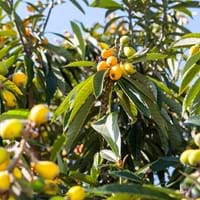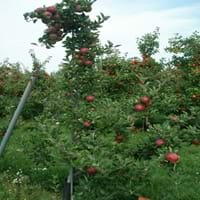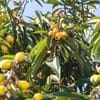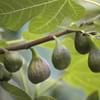Life Span
Perennial
Annual
Origin
China, Japan
Eastern Europe, Southern Europe, Russia/Siberia, Western Asia
Types
Advance, Champagne, Emanuel
Goldrush apple tree, Gala apple tree, Fuji apple tree
Habitat
gardens, Woodlands
Fertile bottom land
USDA Hardiness Zone
8-10
5-9
Sunset Zone
H1, H2, 6, 7, 8, 9, 10, 11, 12, 13, 14, 15, 16, 17, 18, 19, 20, 21, 22, 23, 24
1a, 1b, 2a, 2b, 3a, 10, 11
Habit
Upright/Erect
Oval or Rounded
Flower Color
White
White, Pink
Flower Color Modifier
Bicolor
Bicolor
Fruit Color
Yellow, Orange
Dark Red
Leaf Color in Spring
Olive, Dark Green, Gray
Green
Leaf Color in Summer
Green, Dark Green
Green
Leaf Color in Fall
Green, Dark Green
Green, Light Yellow, Brown
Leaf Color in Winter
Light Green
Light Green
Plant Season
Spring, Summer, Fall, Winter
Spring, Fall
Sunlight
Full Sun, Partial Sun, Partial shade
Full Sun
Growth Rate
Medium
Medium
Type of Soil
Clay, Loam, Sand
Loam
The pH of Soil
Neutral, Alkaline
Acidic, Neutral
Soil Drainage
Well drained
Well drained
Bloom Time
Fall, Late Fall
Spring
Tolerances
Drought
Drought
Where to Plant?
Ground
Ground
How to Plant?
Seedlings
Seedlings
Plant Maintenance
Medium
Medium
Watering Requirements
Requires regular watering
Average Water Needs, Do Not over Water, Requires regular watering
In Summer
Adequately
Lots of watering
In Spring
Alternate Days
Moderate
In Winter
Average Water
Average Water
Soil pH
Neutral, Alkaline
Acidic, Neutral
Soil Type
Clay, Loam, Sand
Loam
Soil Drainage Capacity
Well drained
Well drained
Sun Exposure
Full Sun, Partial Sun, Partial shade
Full Sun
Pruning
Remove damaged leaves, Remove dead branches, Remove dead leaves
Remove crossing or rubbing branches, Remove damaged fruit, Remove damaged leaves, Remove dead branches, Remove dead leaves, Remove dead or diseased plant parts
Fertilizers
All-Purpose Liquid Fertilizer
All-Purpose Liquid Fertilizer, fertilize in growing season, Nitrogen
Pests and Diseases
Red blotch
Red blotch
Plant Tolerance
Drought
Drought
Flower Petal Number
Single
Single
Foliage Texture
Coarse
Medium
Foliage Sheen
Glossy
Matte
Attracts
Birds
Bees, Birds, Wildlife
Allergy
dilation of pupils, weakness
Abdominal pain, Urticaria, Vomiting
Aesthetic Uses
Showy Purposes
Not Used For Aesthetic Purpose
Beauty Benefits
Skin irritation
Good for skin
Environmental Uses
Air purification
Air purification, Food for animals, Food for birds, Food for insects
Medicinal Uses
anti-cancer, Antioxidants, Detoxifies lever, Diabetes, Skin Redness
High cholestrol, Indigestion, Potassium, Rich in Iron, Vitamin A, Vitamin C
Part of Plant Used
Fruits
Fruits
Other Uses
Used as an ingredient in coffee, Used As Food
Added to salads, Food for animals
Used As Indoor Plant
No
No
Used As Outdoor Plant
Yes
Yes
Garden Design
Container, Edible, Feature Plant, Fruit / Fruit Tree, Street Trees, Topiary / Bonsai / Espalier
Edible, Feature Plant, Fruit / Fruit Tree
Botanical Name
ERIOBOTRYA japonica
MALUS domestica 'Arkansas Black'
Common Name
Japanese Plum Loquat, Loquat
Apple, Arkansas Black Apple, Cooking Apple, Eating Apple
In Hindi
Loquat
Arkansas Black Apple
Tree
In German
Mispel
Arkansas Schwarz Apple
Baum
In French
nèfle
Arkansas noir d'Apple
Arbre
In Spanish
níspero
Arkansas Negro de Apple
Árbol
In Greek
μούσμουλο
Αρκάνσας Μαύρο της Apple
Δέντρο
In Portuguese
nêspera
Arkansas Preto da Apple
Árvore
In Polish
loquat
Arkansas Czarny jabłko
Drzewo
In Latin
loquat
Texas Niger Apple
Arbor
Phylum
Tracheophyta
Not Available
Class
Magnoliopsida
Not Available
Clade
Angiosperms, Eudicots, Rosids
Angiosperms, Eudicots, Rosids
Tribe
Not Available
Not Available
Subfamily
Not Available
Not Available
Number of Species
Not Available
Not Available
Season and Care of Loquat and Arkansas Black Apple
Season and care of Loquat and Arkansas Black Apple is important to know. While considering everything about Loquat and Arkansas Black Apple Care, growing season is an essential factor. Loquat season is Spring, Summer, Fall and Winter and Arkansas Black Apple season is Spring, Summer, Fall and Winter. The type of soil for Loquat is Clay, Loam, Sand and for Arkansas Black Apple is Loam while the PH of soil for Loquat is Neutral, Alkaline and for Arkansas Black Apple is Acidic, Neutral.
Loquat and Arkansas Black Apple Physical Information
Loquat and Arkansas Black Apple physical information is very important for comparison. Loquat height is 460.00 cm and width 460.00 cm whereas Arkansas Black Apple height is 180.00 cm and width 460.00 cm. The color specification of Loquat and Arkansas Black Apple are as follows:
Loquat flower color: White
Loquat leaf color: Olive, Dark Green and Gray
Arkansas Black Apple flower color: White and Pink
- Arkansas Black Apple leaf color: Green
Care of Loquat and Arkansas Black Apple
Care of Loquat and Arkansas Black Apple include pruning, fertilizers, watering etc. Loquat pruning is done Remove damaged leaves, Remove dead branches and Remove dead leaves and Arkansas Black Apple pruning is done Remove crossing or rubbing branches, Remove damaged fruit, Remove damaged leaves, Remove dead branches, Remove dead leaves and Remove dead or diseased plant parts. In summer Loquat needs Adequately and in winter, it needs Average Water. Whereas, in summer Arkansas Black Apple needs Lots of watering and in winter, it needs Average Water.





